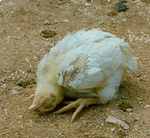Difference between revisions of "Newcastle Disease Virus"
| Line 1: | Line 1: | ||
| − | Newcastle disease is | + | {{unfinished}} |
| + | |||
| + | ==Description== | ||
| + | Newcastle disease virus is the causative agent of Newcastle Disease, an acute viral disease of domestic poultry and many other bird species that is usually fatal. | ||
| + | |||
| + | ==Transmission== | ||
| + | Infected birds shed the virus through droppings and secretions from the nose, mouth and eyes. The virus may also be present in eggs laid during the clinical disease. The virus is commonly transferred by the movement of people and contaminated equipment. | ||
| + | |||
| + | ==Clinical signs== | ||
| + | NDV affects the gastrointestinal, respiratory and nervous systems and clinical signs reflect the system(s) affected. Clinical signs are usually acute and may appear throughout the flock within 2-12 days. Respiratory signs may include dyspnoea, sneezing, nasal discharge and coughing and are common with low virulence infections. | ||
[[Image:Newcastle Disease.jpg|150px|thumb|right|''Newcastle Disease'' <br> L. Mahin, Wikimedia Commons]] | [[Image:Newcastle Disease.jpg|150px|thumb|right|''Newcastle Disease'' <br> L. Mahin, Wikimedia Commons]] | ||
Revision as of 18:43, 29 September 2010
| This article is still under construction. |
Description
Newcastle disease virus is the causative agent of Newcastle Disease, an acute viral disease of domestic poultry and many other bird species that is usually fatal.
Transmission
Infected birds shed the virus through droppings and secretions from the nose, mouth and eyes. The virus may also be present in eggs laid during the clinical disease. The virus is commonly transferred by the movement of people and contaminated equipment.
Clinical signs
NDV affects the gastrointestinal, respiratory and nervous systems and clinical signs reflect the system(s) affected. Clinical signs are usually acute and may appear throughout the flock within 2-12 days. Respiratory signs may include dyspnoea, sneezing, nasal discharge and coughing and are common with low virulence infections.
Hosts
Gallinaceous birds, pigeons, parrots, finches
Subclinical carriers: ducks, ostriches
Pathogenesis
Transmission via aerosol and direct contact Disease ranges from subclinical respiratory tract infections -> torticollis -> haemorrhages and death
Diagnosis
Two diagnostic tests currently exist: Animal test: 1. Samples of trachea and gut of 20 birds are tested in eggs HI using anti-NDV serum (to differentiate HA caused by Avian Influenza Virulence of isolate tested by the speed it kills chicks
2. DNA test (which will soon replace the animal test): Sequencing the cleavage site of H gene The more basic amino acids the more virulent the virus
Control
- Newcastle Disease is NOTIFIABLE
- Vaccination of chickens and racing pigeons
- Surveillance of imported exotic birds
- Isolation of infected stock
- Infected premises to be culled and firebreak cull if spread
